Radon at Kilbourne Hole Maar and Magnetic and Gravimetric Correlations
Abstract
1. Introduction
1.1. Radon in Volcanogenic Deposits
1.2. Study Site and Objective
2. Materials and Method
- A stainless steel probe that is hammered down into the soil at a depth of 70 cm, a length selected because allows for 80% of the CRn, to reach the surface–air border by diffusion [18];
- An air pump to which the probe is coupled through an airtight connector to allow for the flow of only the soil gas. The pump capacity of the Markus 10 instrument is 1.8 L/min;
- A counting chamber in which soil gas is accumulated for 30 s (effective pumping time), followed by a 10 min. measuring time to allow for 218+214Po accumulation;
- A large-area silicon surface barrier detector (SSB) that is coupled to a specific electronic circuitry to count the rate of alpha particles. The instrument displays the average CRn value in kBq/m3.
3. Results
4. Discussion
4.1. Soil Radon Gas Surficial Survey
4.2. Soil Radon Gas Association with Gravity Anomalies
4.3. Correlation of Soil Gas Radon Map with Geomagnetic Field
4.4. Data Analysis by Map Differences
5. Conclusions
Author Contributions
Funding
Institutional Review Board Statement
Informed Consent Statement
Data Availability Statement
Conflicts of Interest
References
- Miklavčić, I.; Radolić, V.; Vuković, B.; Poje, M.; Varga, M.; Stanić, D.; Planinić, J. Radon anomaly in soil gas as an earthquake precursor. Appl. Radiat. Isot. 2008, 66, 1459–1466. [Google Scholar] [CrossRef] [PubMed]
- Baykara, O.; Inceöz, M.; Doğru, M.; Aksoy, E.; Külahcı, F. Soil radon monitoring and anomalies in East Anatolian Fault System (Turkey). J. Radioanal. Nucl. Chem. 2009, 279, 159–164. [Google Scholar] [CrossRef]
- Benà, E.; Ciotoli, G.; Ruggiero, L.; Coletti, C.; Bossew, P.; Massironi, M.; Mazzoli, C.; Mair, V.; Morelli, C.; Galgaro, A.; et al. Evaluation of tectonically enhanced radon in fault zones by quantification of the radon activity index. Sci. Rep. 2022, 12, 21586. [Google Scholar] [CrossRef] [PubMed]
- Al-Hilal, M. Assessment of the tectonic effects on soil radon activity alongthe margin of the Arabian Plate boundary in northwestern Syria. Geofís. Int. 2022, 61, 100–112. [Google Scholar] [CrossRef]
- Rodríguez Ortiz, G. Using Underground Radon to Detect Inactive Geological Faults. Master’s Thesis, University of Texas at El Paso, El Paso, TX, USA, 2017. Available online: https://scholarworks.utep.edu/open_etd/542 (accessed on 3 March 2023).
- López, J.A.; Dena Ornelas, O.; Sajo-Bohus, L.; Rodríguez, G.; Chavarria, I. Correlation Between Underground Radon Gas and Dormant Geological Faults. J. Nucl. Physics, Mater. Sci. Radiat. Appl. 2016, 4, 265–275. [Google Scholar] [CrossRef]
- Girault, F.; Poitou, C.; Perrier, F.; Koirala, B.P.; Bhattarai, M. Soil characterization using patterns of magnetic susceptibility versus effective radium concentration. Nat. Hazards Earth Syst. Sci. 2011, 11, 2285–2293. [Google Scholar] [CrossRef]
- Rusov, V.; Maksymchuk, V.; Ilić, R.; Pavlovych, V.; Jaćimović, R.; Bakhmutov, V.; Kakaev, O.; Vaschenko, V.; Skvarč, J.; Hanžič, L.; et al. The peculiarities of cross-correlation between two secondary precursors—Radon and magnetic field variations, induced by stress transfer changes. Radiat. Meas. 2014, 64, 9–22. [Google Scholar] [CrossRef]
- Perrier, F.; Richon, P.; Sabroux, J.-C. Temporal variations of radon concentration in the saturated soil of Alpine grassland: The role of groundwater flow. Sci. Total. Environ. 2009, 407, 2361–2371. [Google Scholar] [CrossRef] [PubMed]
- Nash, J.T. Volcanogenic Uranium Deposits—Geology, Geochemical Processes, and Criteria for Resource Assessment; Open-File Report 2010-1001; U.S. Geological Survey: Reston, VA, USA, 2010; p. 99. Available online: https://pubs.usgs.gov/of/2010/1001/pdf/OF10-1001.pdf (accessed on 3 March 2023).
- Masuda, K.; Yamamoto, T. Studies on Environmental Contamination by Uranium 2. Adsorption of Uranium on Soil and its Desorption. J. Radiat. Res. 1971, 12, 94–99. [Google Scholar] [CrossRef] [PubMed]
- Cothern, C.R.; Smith, J.E.; Smith, J.E., Jr. Environmental Radon; Springer Science+Business Media: Berlin/Heidelberg, Germany, 1987; Volume 35. [Google Scholar]
- Wilson, L.; Iii, J.W.H. Evidence for a massive phreatomagmatic eruption in the initial stages of formation of the Mangala Valles outflow channel, Mars. Geophys. Res. Lett. 2004, 31, 1051–1054. [Google Scholar] [CrossRef]
- Reiche, P. The Origin of Kilbourne Hole, New Mexico. Am. J. Sci. 1940, 238, 212–225. [Google Scholar] [CrossRef]
- Seager, W.R. Caldera-like Collapse at Kilbourne Hole Maar, New Mexico. New Mex. Geol. Sci. Serv. 1987, 9, 69–73. Available online: https://geoinfo.nmt.edu/publications/periodicals/nmg/9/n4/nmg_v9_n4_p69.pdf (accessed on 3 March 2023).
- Moncada Gutierrez, M. A Geophysical Investigation at The Potrillo Maar. Master’s Thesis, University of Texas at El Paso, El Paso, TX, USA, 2016. Available online: https://scholarworks.utep.edu/open_etd/702 (accessed on 3 March 2023).
- Baskaran, M. Radon: A Tracer for Geological, Geophysical and Geochemical Studies, 1st ed.; Springer Geochemistry; Springer International Publishing: Cham, Switerland, 2016; pp. 2366–6285. [Google Scholar]
- Khan, M.S.A. Study of Radon Gas Diffusion and its Permeability through Some Building Construction Materials by Using SSNTD Technique. Int. J. Sci. Res. 2017, 6, 1599–1602. Available online: https://www.ijsr.net/get_abstract.php?paper_id=ART20171847 (accessed on 3 March 2023).
- Fournier, F.; Groetz, J.E.; Jacob, F.; Crolet, J.M.; Lettner, H. Simulation of Radon Transport through Building Materials: Influence of the Water Content on Radon Exhalation Rate. Transp. Porous Media 2005, 59, 197–214. [Google Scholar] [CrossRef]
- Papachristodoulou, C.; Ioannides, K.; Spathis, S. The effect of moisture content on radon diffusion through soil: Assessment in laboratory and field experiments. Health Phys. 2007, 92, 257–264. [Google Scholar] [CrossRef] [PubMed]
- Maeng, S.; Han, S.Y.; Lee, S.H. Analysis of radon depth profile in soil air after a rainfall by using diffusion model. Nucl. Eng. Technol. 2019, 51, 2013–2017. [Google Scholar] [CrossRef]
- USGS. Topographic Maps. Available online: https://www.usgs.gov/programs/national-geospatial-program/topographic-maps (accessed on 3 March 2023).
- Maksim, N. An Integrated Geophysical Survey of Kilbourne Hole, Southern New Mexico: Implications for Near Surface Exploration of Mars and the Moon. Ph.D. Thesis, University of Texas at El Paso, El Paso, TX, USA, 2016. Available online: https://scholarworks.utep.edu/open_etd/886 (accessed on 3 March 2023).
- Bankey, V.; Cuevas, A.; Daniels, D.; Finn, C.A.; Hernandez, I.; Hill, P.; Kucks, R.; Miles, W.; Pilkington, M.; Roberts, C.; et al. Digital Data Grids for the Magnetic Anomaly Map of North America; Open-File Report 02-414; U.S. Geological Survey: Reston, VA, USA, 2002; p. 2.
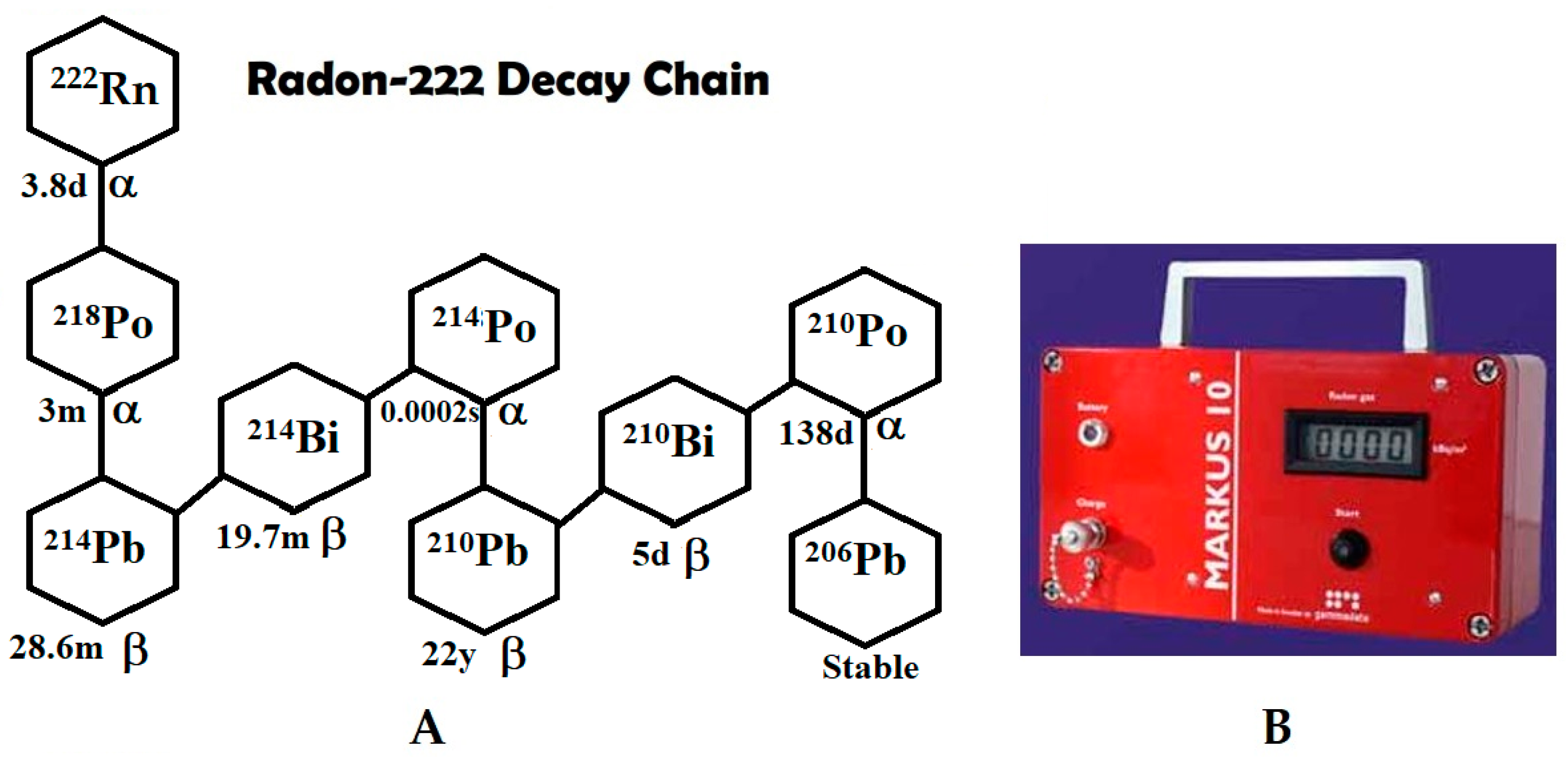
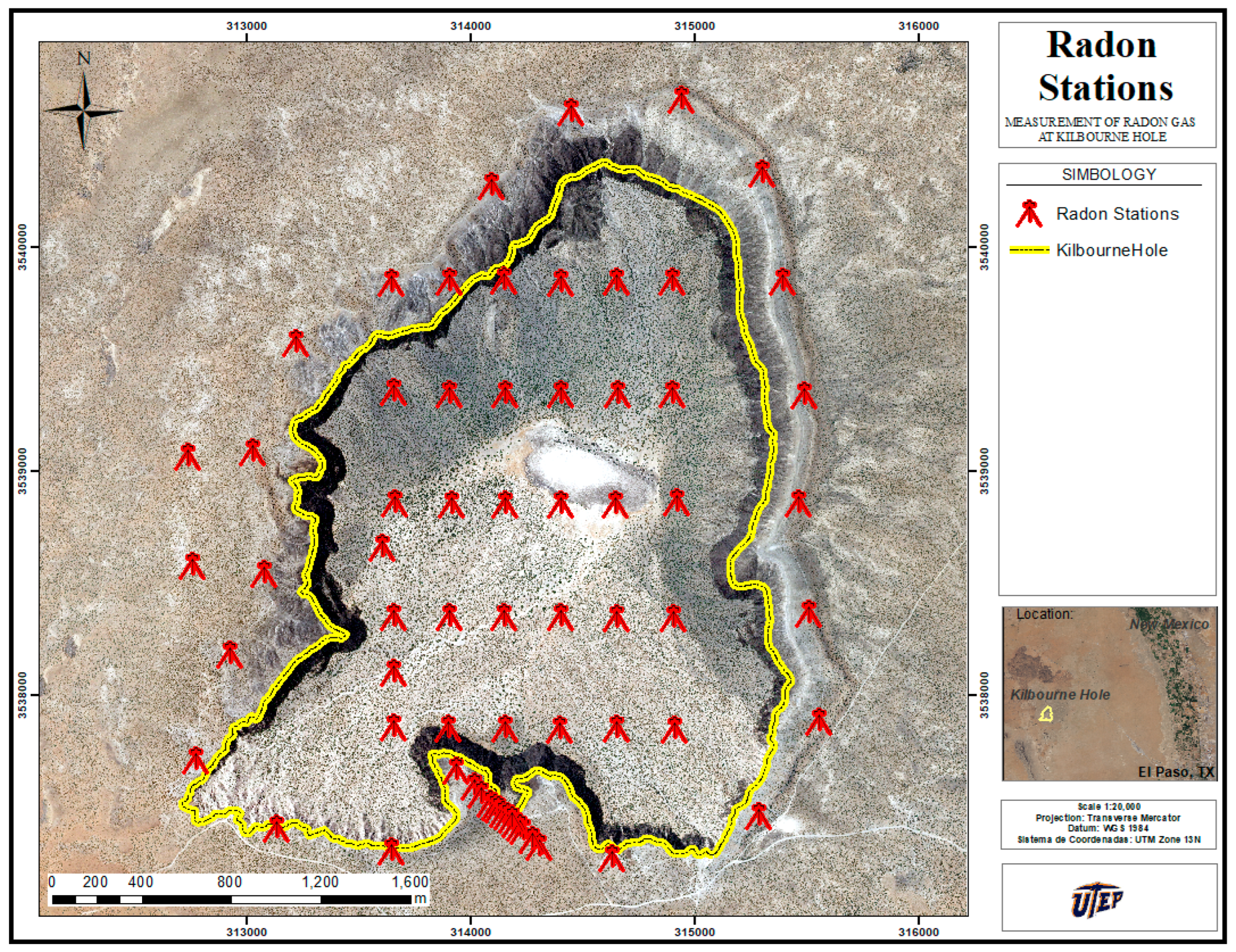
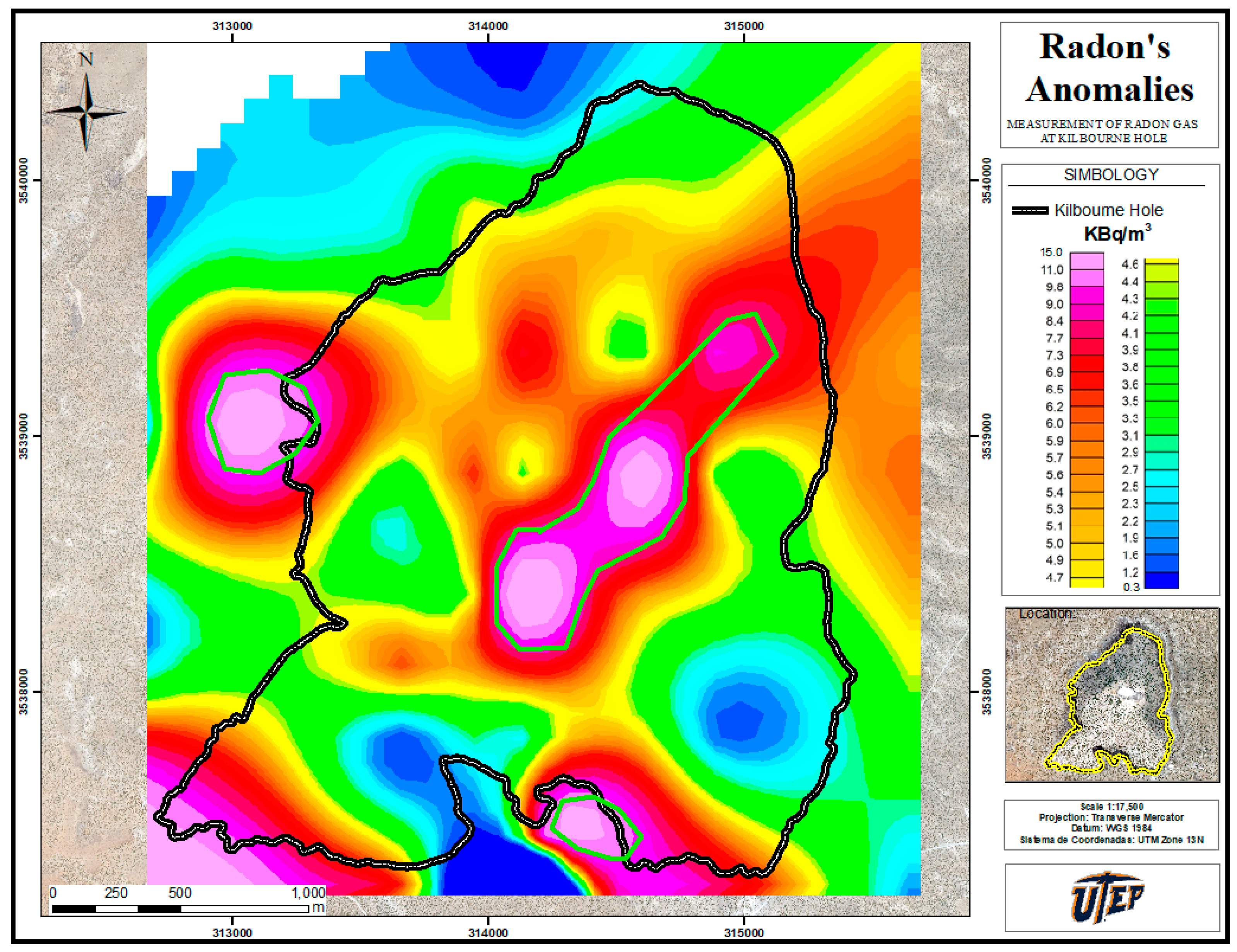
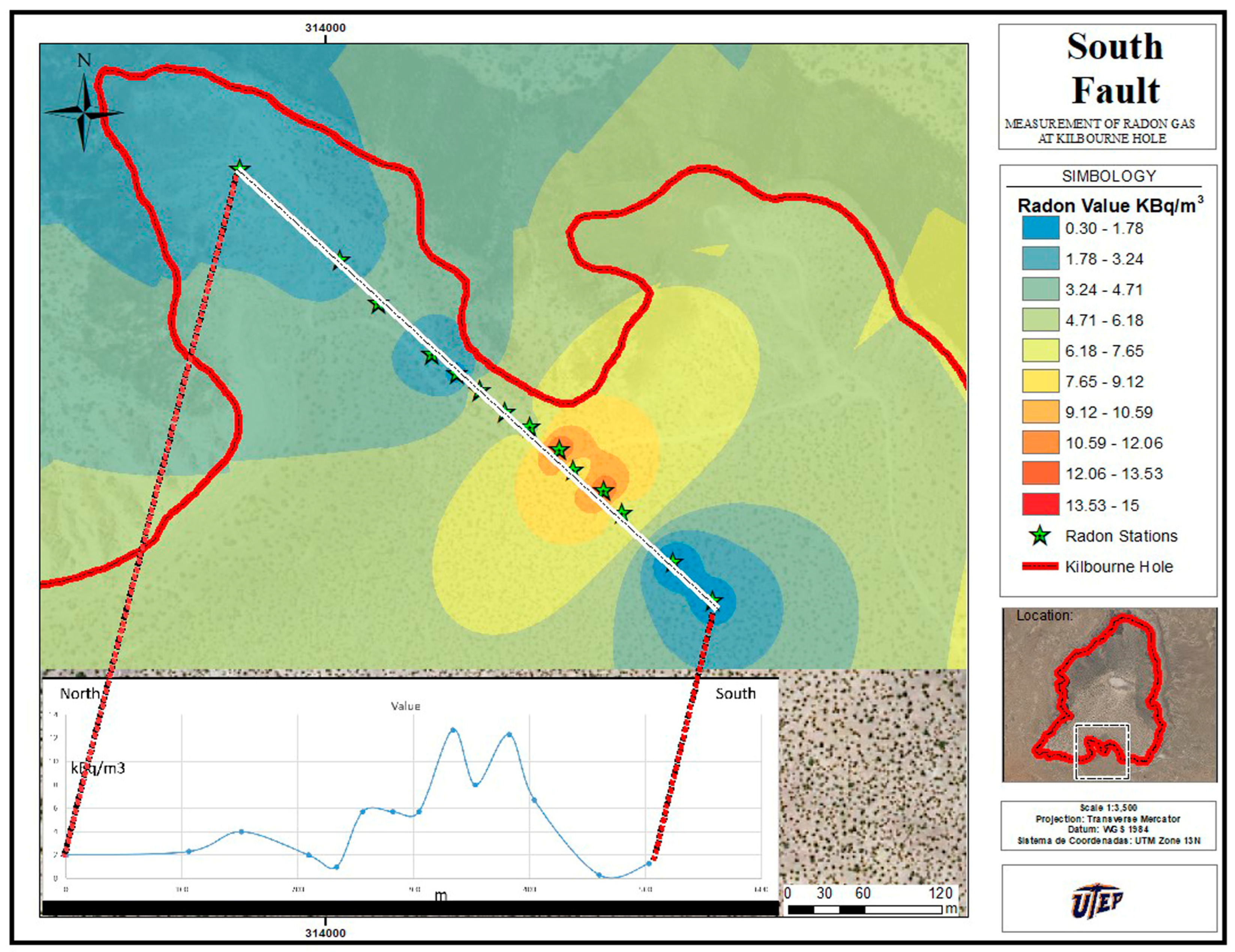
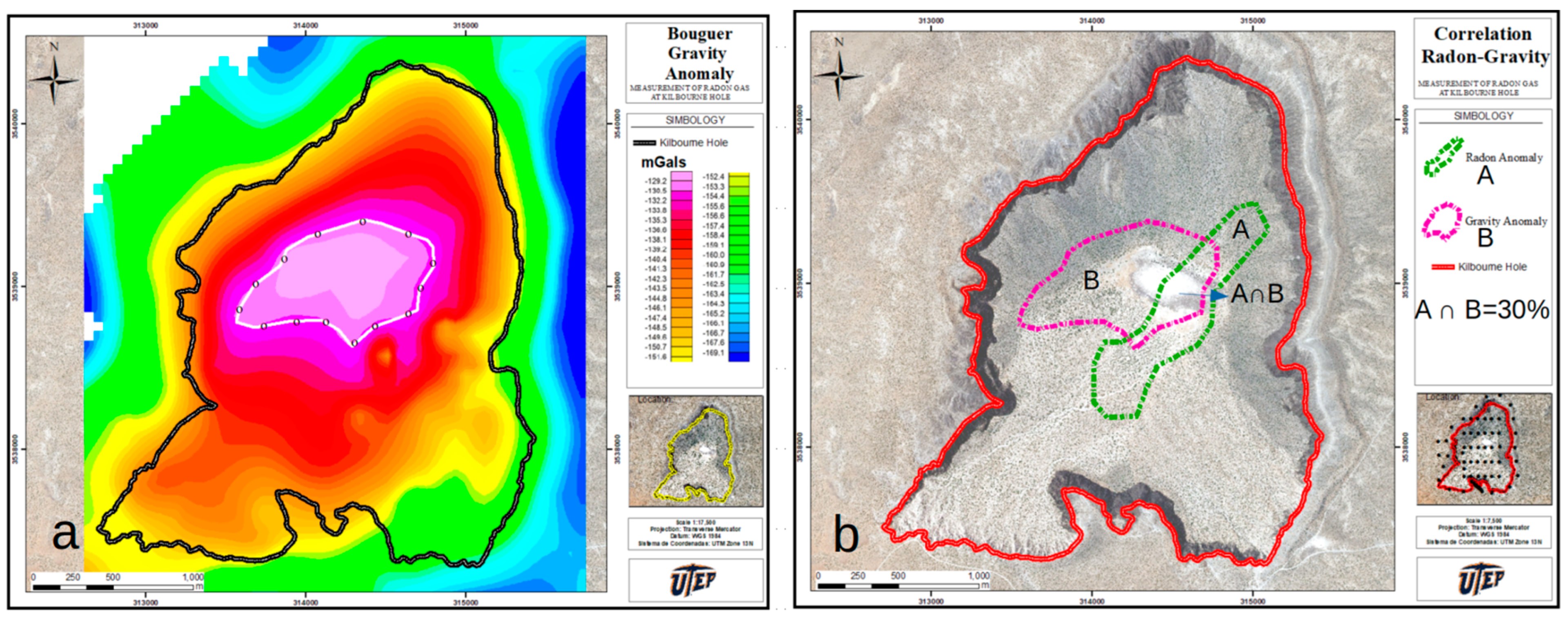
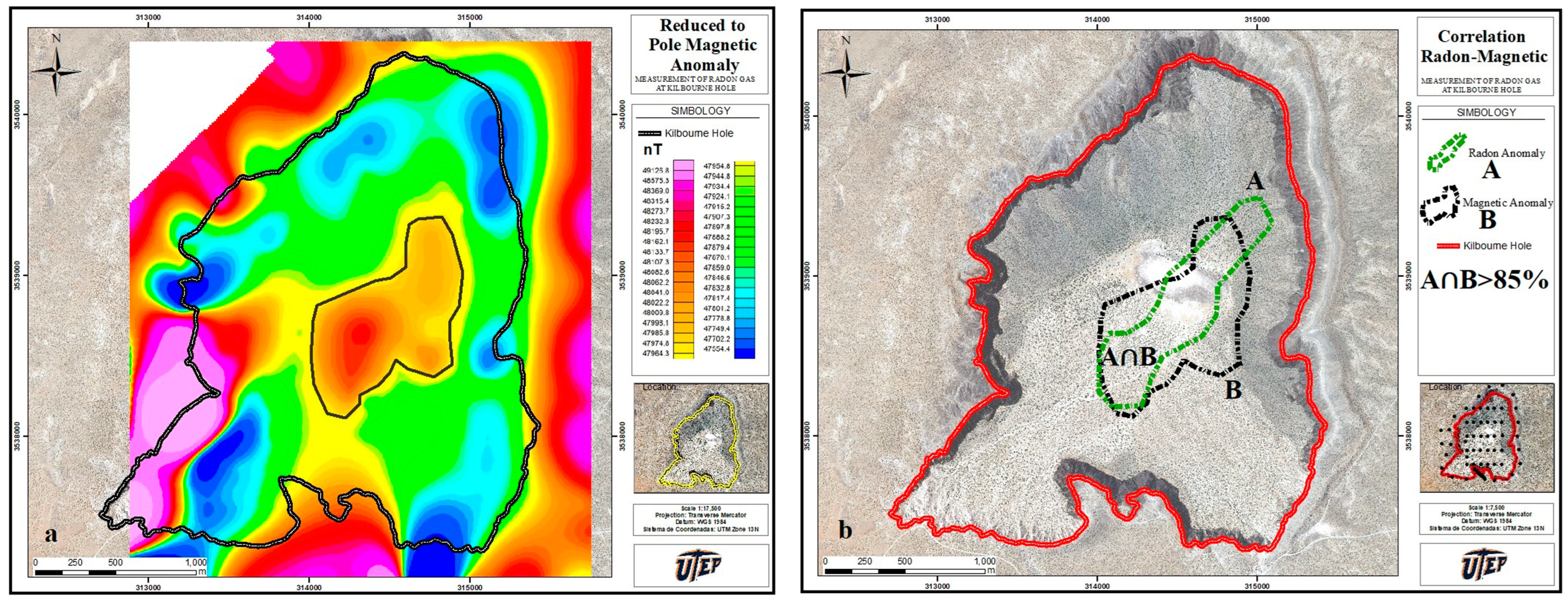

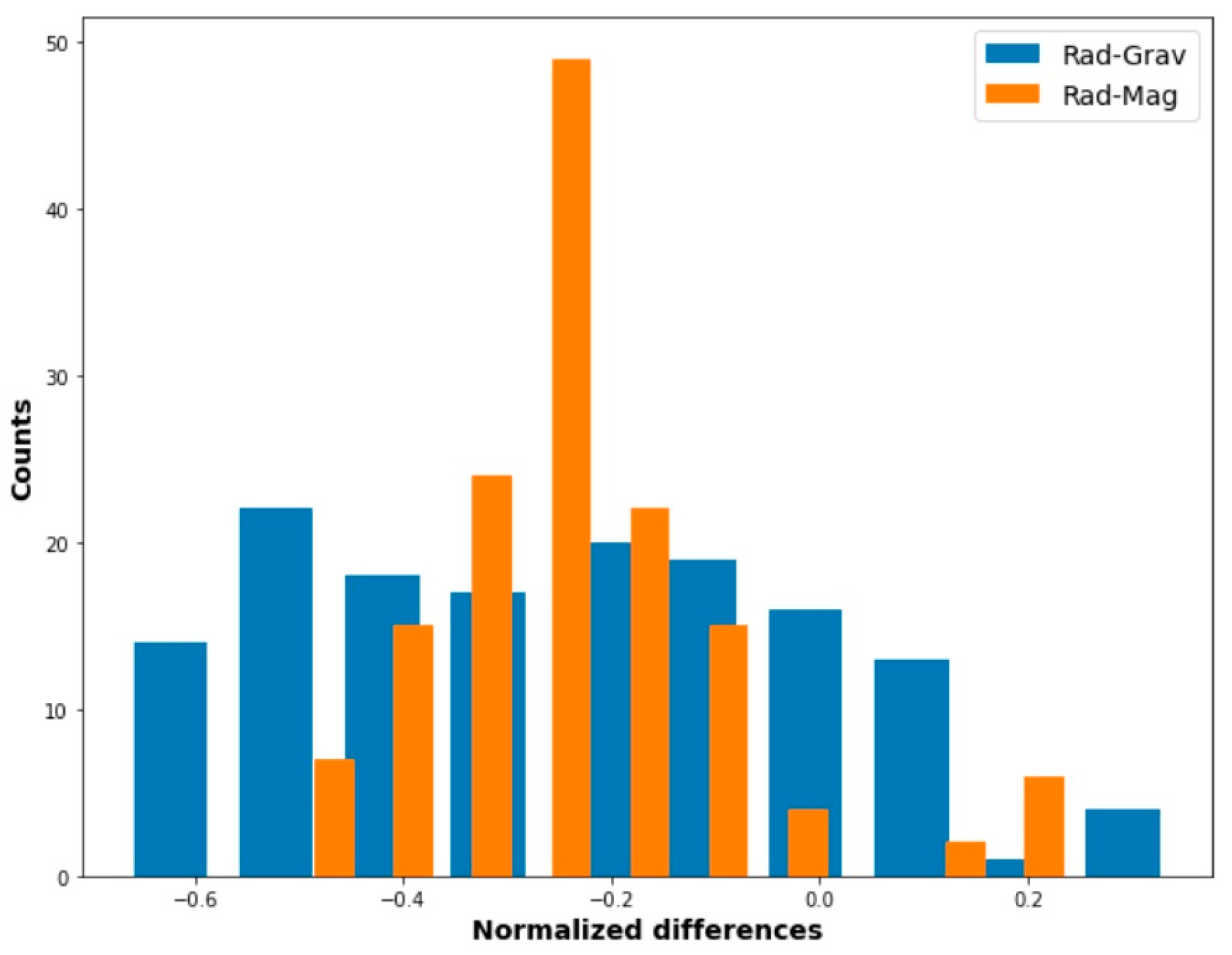
Disclaimer/Publisher’s Note: The statements, opinions and data contained in all publications are solely those of the individual author(s) and contributor(s) and not of MDPI and/or the editor(s). MDPI and/or the editor(s) disclaim responsibility for any injury to people or property resulting from any ideas, methods, instructions or products referred to in the content. |
© 2023 by the authors. Licensee MDPI, Basel, Switzerland. This article is an open access article distributed under the terms and conditions of the Creative Commons Attribution (CC BY) license (https://creativecommons.org/licenses/by/4.0/).
Share and Cite
Luna-Lucero, M.E.; Sajo-Bohus, L.; Lopez, J.A. Radon at Kilbourne Hole Maar and Magnetic and Gravimetric Correlations. Int. J. Environ. Res. Public Health 2023, 20, 5185. https://doi.org/10.3390/ijerph20065185
Luna-Lucero ME, Sajo-Bohus L, Lopez JA. Radon at Kilbourne Hole Maar and Magnetic and Gravimetric Correlations. International Journal of Environmental Research and Public Health. 2023; 20(6):5185. https://doi.org/10.3390/ijerph20065185
Chicago/Turabian StyleLuna-Lucero, Michel E., Laszlo Sajo-Bohus, and Jorge A. Lopez. 2023. "Radon at Kilbourne Hole Maar and Magnetic and Gravimetric Correlations" International Journal of Environmental Research and Public Health 20, no. 6: 5185. https://doi.org/10.3390/ijerph20065185
APA StyleLuna-Lucero, M. E., Sajo-Bohus, L., & Lopez, J. A. (2023). Radon at Kilbourne Hole Maar and Magnetic and Gravimetric Correlations. International Journal of Environmental Research and Public Health, 20(6), 5185. https://doi.org/10.3390/ijerph20065185





